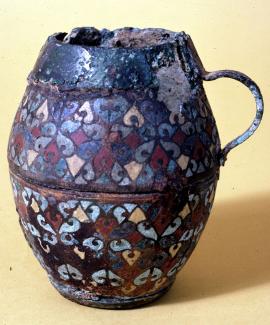This colourful enamelled bronze cup was part of a Roman burial group found at Blackmoor House, Woolmer Forest, the home of the Selborne family, when the house was being rebuilt in 1867.
The cup was contained in an Alice Holt type pottery storage jar along with a human cremation and a worn coin of emperor Lucius Verus (161-169). Also found was a bronze patera, a shallow saucepan. The enamelled cup is dated to the 2nd or 3rd century AD.
Bronze enamelled vessels are quite rare finds, and the pattern on this one is high quality work. It is barrel-shape, and formed of two matching cup-shaped sections. There is an ancient repair to the base.
The body of the cup is covered with an intricate curvilinear design in polychrome enamel, incorporating cells of distinctive leaf-like shapes. There appear to be five colours - red, yellow, dark blue, turquoise and light green - although the last two are very similar in their present condition.
The cup remained in the possession of the Selborne family for many years, before being sold at auction at Christies in 1975. In 1983 it was bought by Hampshire County Council Museums Service.
"the pattern ….. is high quality work."
The area around Blackmoor House, Woolmer Forest has seen a number of discoveries of Roman material over the years. In 1741, as Gilbert White records in the Natural History of Selborne, Woolmer Pond dried up and several hundred copper coins, including some of Marcus Aurelius (AD 146-180), were revealed. Thirty years later another hoard was discovered nearby, contained in a pottery vessel. This featured coins from the time of Claudius (AD 43) to that of Commodus (AD 192).
The enamel is in a good state, though the base metal itself is damaged and corroded in many places and there is considerable iron corrosion over the surface, presumably from the circumstances of the burial environment. Did you know? When the cup came into the museum’s possession the two halves were stuck together with old postage stamp edging paper and there was some evidence of corrosion. It was given a careful cleaning by the conservator of antiquities under a low-power microscope, treated with chemicals to prevent the spread of corrosion, and strengthened. To reinforce the base and stick the halves back together, an adhesive was used which can be easily removed if necessary.



